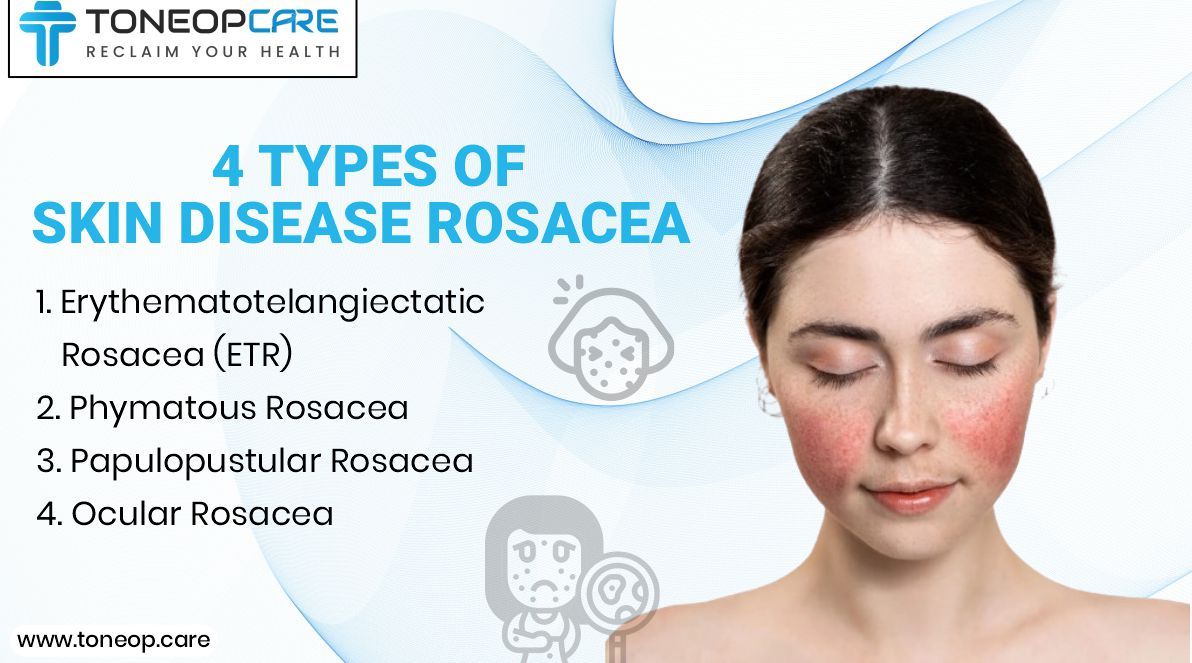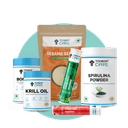We assure you that you won’t be alone on your journey towards becoming your healthier self.
Health & Wellness
Understanding The Skin Disease Rosacea: Symptoms, Causes, Triggers, And Effective Management Strategies

Rosacea is a long-lasting skin condition characterised by inflammation that mainly impacts the facial area. It presents with noticeable redness, swelling, and acne-like eruptions, primarily on the cheeks, nose, chin, and forehead. Rosacea can greatly affect how a person looks, and as a result, their self-confidence and emotional health may be hindered.
Although the specific cause of rosacea is not known, it is believed that a mix of genetic, environmental, and lifestyle elements plays a role in its onset. While rosacea cannot be cured, treatments can effectively manage symptoms. In this article, we will examine the various types of rosacea, its signs, reasons, factors that worsen it, and treatment choices.
Table Of Contents
1. 4 Types Of Skin Disease Rosacea
2. What Is The Main Cause Of Rosacea?
3. What Are The Symptoms Of Rosacea?
4. 6 Triggers Of Rosacea To Watch Out For
5. Is Rosacea A Serious Condition?
6. What Is The Best Treatment For Rosacea?
7. Dietitian's Recommendation
8. The Final Say
9. FAQs
10. References
4 Types Of Skin Disease Rosacea

Individuals with rosacea frequently have a genetic tendency, indicating the possibility for the condition to be hereditary. Besides genetics, an overactive immune system can also cause an abnormal inflammatory reaction, resulting in redness and swelling of the skin. Rosacea can be differentiated as:
1. Erythematotelangiectatic Rosacea (ETR)
This category is identified by constant redness on the face, flushing, and noticeable blood vessels (telangiectasia). It commonly impacts individuals with light skin and worsens over time if left untreated.
2. Phymatous Rosacea
This condition involves the skin becoming thicker, especially on the nose (known as rhinophyma). The skin might have a rough texture, and the nose could appear swollen and round.
3. Papulopustular Rosacea
Frequently confused with acne, this variation displays red bumps (papules) and pimples filled with pus (pustules). The main impact is on the central portions of the face and can result in redness as well.
4. Ocular Rosacea
This specific variety affects the eyes, causing the eyelids to become dry, irritated, red, and swollen. If not treated, ocular rosacea could cause vision issues in serious situations.
While we will be discussing this topic more, you can consider ToneOp Care’s Skin 360 Tablets, which can play a key role in skin disorders and promote even skin tone. It can help alleviate symptoms of skin disorders like dry skin and psoriasis and also prevent inflammation due to the skin disease rosacea.
What Is The Main Cause Of Rosacea?
Although the specific cause of rosacea is difficult to pinpoint, a mix of genetic and environmental influences appears to be involved. An overactive immune system, abnormalities in blood vessel function, or an increased inflammatory reaction could cause rosacea.
Some of the contributing factors include:
1. Genetics
Having a family history of rosacea increases the likelihood of developing the condition. People with Northern European ancestry, particularly those with light skin, are at a higher risk.
2. Immune System Dysregulation
Rosacea may be associated with an excessive immune reaction, resulting in skin inflammation and hampering your immune system. Demodex folliculorum, a bacteria frequently found on the skin, is more prevalent on skin with rosacea, but its specific function is not yet understood.
3. Vascular Abnormalities
Irregular blood vessel activity and heightened blood vessel sensitivity in the facial area can result in flushing and continuous redness. This symptom is frequently made worse by heat and sun exposure.
4. Environmental Triggers
Different external elements, such as exposure to the sun, chilly temperatures, strong winds, and consumption of spicy meals, can activate or exacerbate rosacea symptoms. Hot beverages, exercise, and anxiety can also trigger flare-ups.
Also Read: Herb-ify Your Health: 17 Immune-Boosting Herbs And Supplements To Shield Your Body From All Diseases
What Are The Symptoms Of Rosacea?
A key factor in rosacea is the widening of blood vessels in the face, which leads to increased skin sensitivity and a tendency to flush. Environmental factors like sunlight, stress, extreme temperatures, and specific foods can worsen the condition as they expand blood vessels.
Another hypothesis revolves around the function of tiny mites that naturally inhabit humans' skin. Individuals with rosacea often have elevated quantities of these mites, potentially causing more inflammation; however, their precise impact is still unknown.
Symptoms of rosacea differ from individual to individual, but typical indications include:
- Ongoing redness on the face, specifically on the cheeks, nose, and forehead.
- Transient flushing may come and go.
- Small red or pus-filled bumps resembling acne.
- Telangiectasia is a blood vessel visible on the skin.
- Dry, irritated, or swollen eyes (in cases of ocular rosacea)
- Thickening of the skin, particularly near the nasal area (rhinophyma)
- Feelings of heat or prickling in the affected areas
6 Triggers Of Rosacea To Watch Out For
Here are 6 common triggers of rosacea:
1. Sun Exposure
UV radiation is commonly cited as a trigger of rosacea. To reduce flare-ups, it is essential to wear broad-spectrum sunscreen every day.
Stress:
2. Stress, Anxiety, And Depression
Increased emotional stress, anxiety, and depression can worsen symptoms of rosacea. Utilising mindfulness, meditation, and relaxation methods can potentially decrease the occurrence of flare-ups by managing stress.
Also Read: 15 Best Ways To Reduce Stress And Anxiety Quickly At Home
3. Dietary Triggers
Some individuals may experience rosacea symptoms triggered by specific foods and drinks like spicy foods, alcohol (particularly red wine), hot drinks, and caffeine.
4. Extreme Weather Conditions
Rosacea can be worsened by both hot and cold temperatures and strong winds. Rapid shifts in temperature, like transitioning from a chilly space to a warmer one, may cause flushing.
5. Physical Exertion
Intense physical activity can lead to overheating and flushing, potentially causing a flare-up.
6. Skin Care Products
Harsh cleansers, astringents, and products containing alcohol, fragrances, or irritating ingredients can exacerbate rosacea symptoms. It is crucial to use gentle, hypoallergenic skincare products.
Also Read: How To Apply Rice Flour On The Face For Flour-ishing Glow? DIY Masks, Benefits & Uses
Is Rosacea A Serious Condition?
While rosacea is not fatal, it can pose significant challenges for individuals experiencing its symptoms. Regarding physical effects, rosacea leads to constant redness, bumps, and noticeable blood vessels on the face, which can escalate if not addressed. In certain instances, rosacea can impact the eyes (known as ocular rosacea), irritating and, in uncommon situations, potential vision issues if it progresses significantly.
A different form of rosacea, known as phymatous rosacea, can thicken skin, particularly on the nose, resulting in rhinophyma. These alterations in the body can significantly affect how a person looks.
In addition to the physical symptoms, rosacea can also lead to significant emotional and psychological impacts. Individuals suffering from rosacea frequently experience low self-esteem, resulting in feelings of anxiety, avoidance of social situations, and diminished overall satisfaction with their lives.
Proper treatment management can prevent these problems from getting worse. Even though there is no cure for rosacea, the condition can usually be controlled with medical treatment and lifestyle changes.
Also Read: 20 Benefits Of Cinnamon For Skin With DIY Skincare Remedies & Side Effects To Watch Out For!
What Is The Best Treatment For Rosacea?
There is no single “best” treatment for rosacea because the condition varies from person to person. The proper treatment depends on the type and severity of rosacea, as well as individual skin sensitivities. However, common treatments include:
1. Topical Medications
Creams such as metronidazole or azelaic acid can assist in decreasing inflammation and redness. These drugs are frequently prescribed for mild to moderate instances of rosacea.
2. Oral Antibiotics
For more severe cases, oral antibiotics like doxycycline may be prescribed to reduce inflammation, not just to fight infection. This helps control symptoms like bumps and redness.
3. Laser And Light Therapy
Laser treatments can be highly effective for persistent redness or visible blood vessels. They target and reduce the appearance of dilated blood vessels beneath the skin.
4. Lifestyle Changes
Avoiding known triggers like sun exposure, spicy foods, and extreme temperatures can also help prevent flare-ups. Using sunscreen and gentle skincare products is crucial.
Also Read: 10 Anti-Inflammatory Foods For Skin, Diet Plan For Psoriasis & Ways To Reduce It
Dietitian's Recommendation
To aid in controlling rosacea with your diet, prioritise foods high in antioxidants with anti-inflammatory properties. Include a lot of fruits, vegetables, and omega-3 fatty acids from walnuts, fish like salmon, and flaxseeds to decrease inflammation.
Steer clear of common triggers like spicy foods, alcohol (especially red wine), caffeine, and hot drinks, which can worsen flare-ups. Keep yourself hydrated and incorporate probiotics from yoghurt or kefir into your diet to promote gut health, potentially lessening skin inflammation. Maintaining a food journal can assist in recognising individual triggers.
Dt. Akshata Gandevikar
The Final Say
Rosacea is a persistent skin disorder that can have a major emotional and physical impact on a person's quality of life. Although there is no known cure, effective therapies and lifestyle modifications can help control the symptoms, stop flare-ups, and enhance skin health.
By identifying personal triggers and adopting a gentle skincare routine, individuals with rosacea can regain control over their skin and feel more confident in their appearance.
FAQs
1. How can rosacea go away?
Rosacea cannot be cured; it can be managed with medication. The symptoms will determine the course of treatment, which often consists of a mix of medicine and self-care techniques.
2. Who is most at risk for skin condition rosacea?
People with fair skin, particularly those of Northern European descent, are more prone to developing rosacea. It often runs in families, so genetics plays a role. It typically affects adults between the ages of 30 and 50, and women are more likely to develop it than men, though men may experience more severe symptoms, like skin thickening (rhinophyma).
3. What skincare products are best for skin problem rosacea?
For rosacea, use gentle, fragrance-free, and hypoallergenic skincare products. Avoid harsh cleansers, scrubs, or alcohol-based products that can irritate sensitive skin. Opt for moisturisers that soothe and hydrate, and always use broad-spectrum sunscreen with SPF 30 or higher to protect against sun-induced flare-ups.
4. Can rosacea skin condition affect the eyes?
Yes, ocular rosacea is a subtype that affects the eyes, causing dryness, redness, irritation, and swelling of the eyelids. Not treated can result in vision issues.
References
- https://www.mayoclinic.org/diseases-conditions/rosacea/symptoms-causes/syc-20353815
- https://my.clevelandclinic.org/health/diseases/12174-rosacea
- https://www.medicalnewstoday.com/articles/160281#types
- https://www.pfizer.com/disease-and-conditions/rosacea
About ToneOp Care
ToneOp Care is the ultimate destination for high-quality nutraceutical supplements and ayurvedic products in India! We are proud to offer a significant range of products designed to support your overall health and well-being, including weight loss, muscle gain, immunity, skin and hair care, and women's health. All our products are manufactured in India using the latest technology and facilities, ensuring the highest quality standards.


